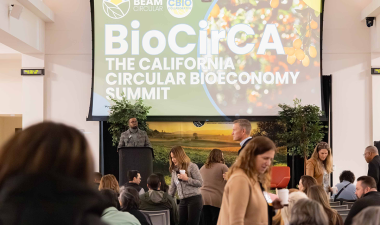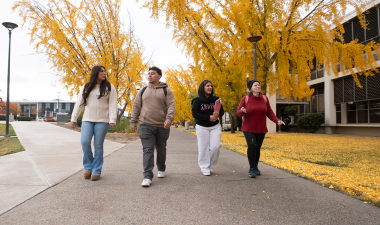Vivian Aguilar is ready to graduate in May with a degree in psychology and had plans to work toward an advanced degree to prepare for a career in the medical field, focusing on behavioral changes to prevent and treat disease and addiction.
That may still happen, but Aguilar is pondering other psychology options after working this semester with Julia Sankey, professor of geology and paleobiology, and more recently, a class called "Climate Crisis and Solutions," on a Research, Scholarship and Creative Activities (RSCA) grant.
Like Aguilar, Sankey’s scholarly interests have shifted. Sankey had taught courses about dinosaurs and led expeditions to search for fossils, but spending three years as a member of the Council for Sustainable Futures helped her pivot from the prehistoric world to the contemporary crisis.
She and Aguilar spent this spring estimating the number of miles Stanislaus State students drive, which contributes to greenhouse gas emissions. They are searching for policies to address this massive commuting challenge at Stan State, in the California State University system and at local and state air quality resource management agencies.
In a 15-minute presentation that Sankey has delivered to more than a dozen groups on campus, she shares the basic data: Based on pre-Covid attendance data provided by Institutional Effectiveness and Analytics office, 10,006 students commuted to the Turlock campus an average of 28.4 miles each way three times a week, totaling 51.3 million miles a year. That doesn’t include faculty and staff commuting miles, which are harder to track, but commuting to and from Stan State is responsible for a huge amount of greenhouse gas emissions that contribute to air pollution. Combined with heat and sunlight, the emissions are toxic.
"The Central Valley of California has some of the worst air quality in the United States,” Sankey said. “Central Valley folks live shorter lives. There are probably many reasons, but air quality is one of them. That’s not fair. That’s the consequence of living with polluted air throughout a lifetime from fetus to being a senior.”
Tiny particulate matter from wildfires and diesel exhaust from trucks on Highway 99 and Interstate 5 are components, but so, too, is car exhaust.
“One of the questions I had was whether Stanislaus State is one of the biggest polluters of the area,” Sankey said. “If you consider the numbers of commuters to and from campus including students, staff, and faculty, we may be.”
Data on student commuting patterns alone indicates the answer is yes. (The two are estimating staff and faculty commuting distances, now).
“Our campus is trying very hard to be more sustainable,” Sankey said. “There's more solar. There are great water catchment systems. Yet, when you think about getting to and from campus, we are not sustainable. We are a big source of air pollution in the valley.”
One solution she and Aguilar will present to President Ellen Junn is modifying the traditional academic schedule. If Stan State eliminates all Friday face-to-face classes, students’ total commute drops to 34.2 million miles per year vrs. 51.3 million miles.
Improving public transportation is another key solution, and Aguilar has dedicated a lot of time to understanding local resources available to the Stan State community.
She learned Associated Students, Inc has paid Turlock Transit to provide students with free access since 2017. It has spent $90,000 each of the past two years. At its peak in October 2019, more than 2,700 students used Turlock Transit. Post-pandemic, students are required to request a 31-day pass online to ride for free, but thus far, only 201 have done so.
Negotiating with Stanislaus Regional Transit Authority to better serve students who live elsewhere in the region is one of Sankey’s and Aguilar’s recommendations. So too, is for Stan State to purchase an electric shuttle bus to make trips back and forth between the Stockton and Turlock campuses and possibly add other stops along the route.
Establishing a ride-sharing program is another recommendation.
In her research, Aguilar discovered Miocar, an electric car-sharing vehicle one can rent, and Vamos, a smartphone app that connects residents to affordable, clean transportation options, including the electric car-hailing service VOGO.
“The most surprising thing is I haven’t found a CSU policy that mandates specific reductions in greenhouse gas emissions,” Aguilar said. “The only CSU policy mentions reducing emissions from university-associated transportation and says to ‘encourage and promote,’ which is surprising with Gov. Gavin Newsom pushing for electric vehicles and reducing emissions from commuting."
Aguilar and Sankey both assumed someone on campus or at the Office of the Chancellor was studying the problem of commuter pollution. They have not found anyone who is. Stan State’s sustainability efforts are largely confined to the 228 acres that comprise the Turlock campus and the Stockton Campus located at University Park.
The paradox is that CSU campuses were designed as largely commuter universities, spaced throughout the state to make a four-year higher education accessible to more students. Now, the effect of serving some 450,000 students and staff across 23 campuses is contributing to the climate crisis.
Sankey said she hopes Stan State, one of the biggest institutions in the region, can address the issue in such a way as to serve as a model for other area companies.
Aguilar took Sankey’s course on the climate crisis and solutions because she’s an officer in Climate Action Now and wanted to learn about solutions. She is invested in continuing the research she and Sankey have begun.
“It’s made me want to have a career that’s oriented toward environmentalism,” Aguilar said. “It will be difficult being a psychology major. That's why I've been putting off applying for any master's programs. I want to search for one that will involve psychology and the climate crisis.”
It can be done, she believes.
“A big challenge with employing or enforcing widespread sustainability efforts would be encouraging people or motivating people to engage in these efforts,” Aguilar said. “It seems like there needs to be a societal transformation in our values and attitudes toward nature and environmentalism, and there should be a greater focus on making sustainable efforts more accessible and affordable.”


